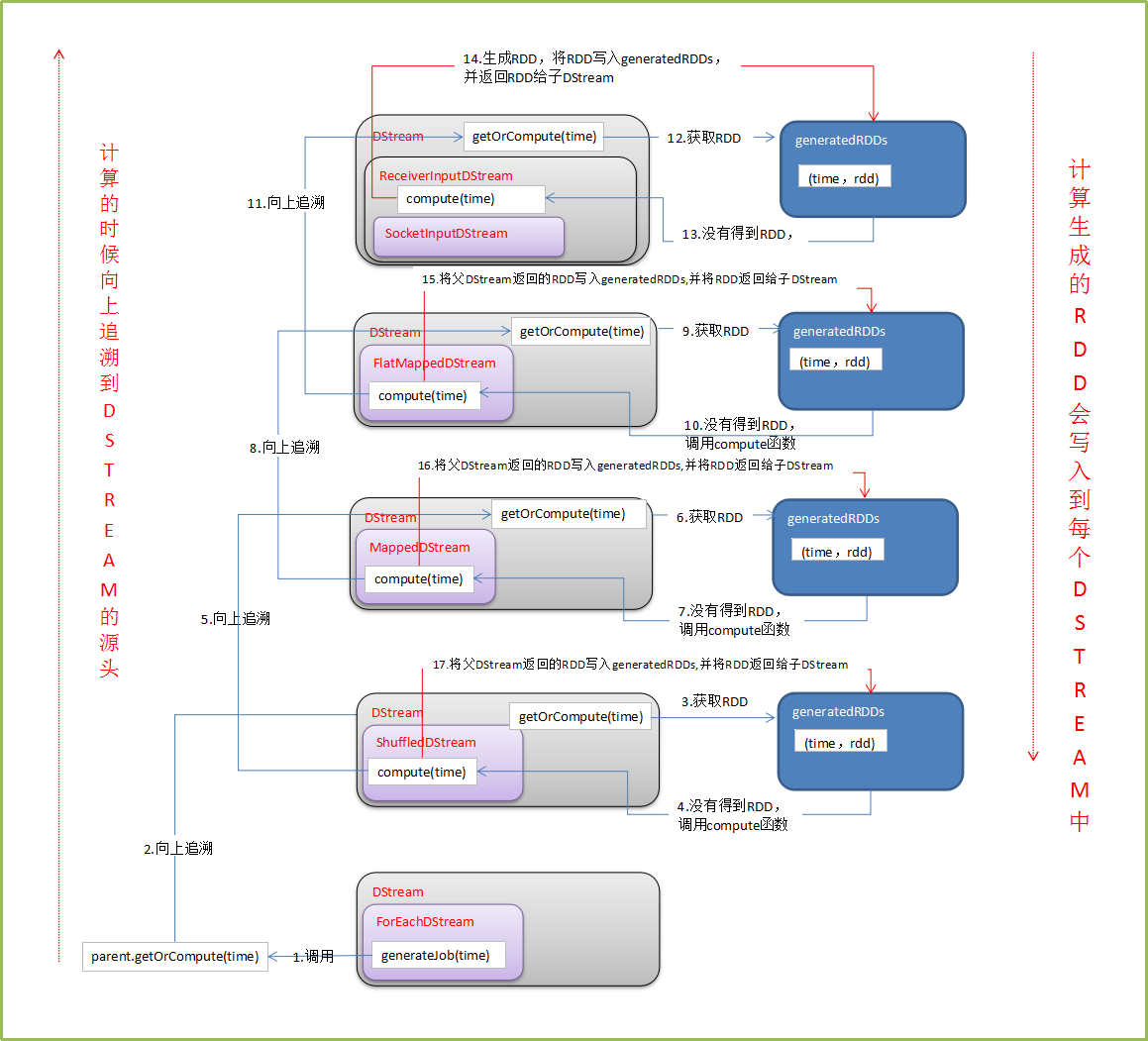DStream是RDD的模板,每隔一个batchInterval会根据DStream模板生成一个对应的RDD。然后将RDD存储到DStream中的generatedRDDs数据结构中:
// RDDs generated, marked as private[streaming] so that testsuites can access it @transient private[streaming] var generatedRDDs = new HashMap[Time, RDD[T]] ()
下面我们以一个实际的例子来说明DStream中RDD的生成的全周期。
val lines = ssc.socketTextStream("localhost", 9999)
val words = lines.flatMap(_.split(" "))
val pairs = words.map(word => (word, 1))
val wordCounts = pairs.reduceByKey(_ + _)
wordCounts.print()
代码可以‘翻译’成如下代码:
val lines = new SocketInputDStream("localhost", 9999)
// 类型是 SocketInputDStream
val words = new FlatMappedDStream(lines, _.split(" "))
// 类型是 FlatMappedDStream
val pairs = new MappedDStream(words, word => (word, 1))
// 类型是 MappedDStream
val wordCounts = new ShuffledDStream(pairs, _ + _)
// 类型是 ShuffledDStream
new ForeachDStream(wordCounts, cnt => cnt.print())
// 类型是 ForeachDStream
我们先看看DStream的print方法:
def print(num: Int): Unit = ssc.withScope {
def foreachFunc: (RDD[T], Time) => Unit = {
(rdd: RDD[T], time: Time) => {
val firstNum = rdd.take(num + 1)
// scalastyle:off println
println("-------------------------------------------")
println("Time: " + time)
println("-------------------------------------------")
firstNum.take(num).foreach(println)
if (firstNum.length > num) println("...")
println()
// scalastyle:on println
}
}
foreachRDD(context.sparkContext.clean(foreachFunc), displayInnerRDDOps = false)
}
首先定义了一个函数,该函数用来从RDD中取出前几条数据,并打印出结果与时间等。后面会调用foreachRDD函数。
private def foreachRDD(
foreachFunc: (RDD[T], Time) => Unit,
displayInnerRDDOps: Boolean): Unit = {
new ForEachDStream(this,
context.sparkContext.clean(foreachFunc, false), displayInnerRDDOps).register()
}
在foreachRDD中new出了一个ForEachDStream对象。并将这个注册给DStreamGraph 。
ForEachDStream对象也就是DStreamGraph中的outputStreams。
private[streaming] def register(): DStream[T] = {
ssc.graph.addOutputStream(this)
this
}
def addOutputStream(outputStream: DStream[_]) {
this.synchronized {
outputStream.setGraph(this)
outputStreams += outputStream
}
}
当到达batchInterval的时间后,会调用DStreamGraph中的generateJobs方法
def generateJobs(time: Time): Seq[Job] = {
logDebug("Generating jobs for time " + time)
val jobs = this.synchronized {
outputStreams.flatMap { outputStream =>
val jobOption = outputStream.generateJob(time)
jobOption.foreach(_.setCallSite(outputStream.creationSite))
jobOption
}
}
logDebug("Generated " + jobs.length + " jobs for time " + time)
jobs
}
然后就调用了outputStream也就是ForEachDStream的generateJob(time)方法:
override def generateJob(time: Time): Option[Job] = {
parent.getOrCompute(time) match {
case Some(rdd) =>
val jobFunc = () => createRDDWithLocalProperties(time, displayInnerRDDOps) {
foreachFunc(rdd, time)
}
Some(new Job(time, jobFunc))
case None => None
}
}
从这个方法开始,一直向DStream的依赖关系追溯上去。到最初的DStream,然后生成新的RDD,并将RDD写入generatedRDDs中。过程如下图:
备注:
1、DT大数据梦工厂微信公众号DT_Spark
2、IMF晚8点大数据实战YY直播频道号:68917580
3、新浪微博: http://www.weibo.com/ilovepains
转载于:https://blog.51cto.com/lqding/1773398





















 1万+
1万+











 被折叠的 条评论
为什么被折叠?
被折叠的 条评论
为什么被折叠?








